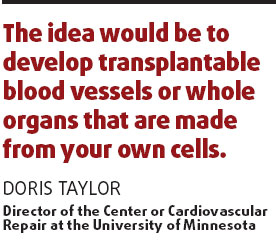Dead animal hearts reanimated
|
A picture released by the University of Minnesota shows (from left) the recellularization of a rat heart. AFP |
PARIS: In experiments that would make Dr Frankenstein jealous, US scientists have coaxed recycled hearts taken from animal cadavers into beating in the laboratory after reseeding them with live cells, according to a study released Sunday.
If extended to humans, the procedure could provide an almost limitless supply of hearts, and possibly other organs, to millions of terminally ill people waiting helplessly for a new lease on life.
Some 22 million people worldwide are living with the threat of heart failure.
"The idea would be to develop transplantable blood vessels or whole organs that are made from your own cells," says lead researcher Doris Taylor, director of the Center or Cardiovascular Repair at the University of Minnesota.
While there have been advances in generating living heart tissue in the lab, this is the first time an entire, three-dimension bio-artificial heart has been brought to life.
The core procedure making this possible is called decellularisation.
In this process, all the cells from an organ - in this case the heart of a dead rat - are stripped away using powerful detergents, leaving only a bleached-white scaffolding composed of proteins secreted by the cells.
In the experiments, this matrix was then injected with a mixture of cells taken from newborn rat hearts and placed in a sterile lab setting, where the scientists hoped it would grow.
After only four days, contractions started, and on the eighth day, the hearts were pumping, according to the study, published in the British journal Nature Medicine.
The researchers were stunned.

"When we saw the first contractions, we were speechless," says Harald Ott, a surgeon at Massachusetts General Hospital.
"We certainly were surprised that it worked so well and so quickly," Taylor says. "There are so many places this could have gone wrong."
In humans the objective would be to inject stemcells drawn directly from the recipient of the donated organ, thus eliminating the danger that the new heart would be rejected by the immune system.
Recent breakthroughs in stemcell research from non-embryo sources mean that new tissues should be easy to generate, according to the authors.
Many patients who might one day benefit from a transplanted bio-artificial organ are currently not even listed as potential recipients, says Ott. "If organs derived from a patient's own cells would become available on a large scale - maybe even as an off-the-shelf product - millions of patients suffering from organ failure would benefit," he says.
In these "proof of concept" experiments, the bio-artificial rat hearts grown in the lab pumped, after eight days, with a force equivalent to about two percent of an adult rodent heart.
Taylor and her team are now working on making the recycled organs more efficient, and have even transplanted some of these hearts into the abdomens of rats and connected them to the animals' aortas, a standard way of testing whether a donor organ can keep an animal alive.
Decellularisation could change the way scientists thinks about engineering organs, according to the study. "It opens a door to this notion that you can make any organ: kidney, liver, lung, pancreas - you name it and we hope we can make it," Taylor says.
Though not reported in this study, the Minnesota researchers have also successfully applied the technique to pig hearts, which are closer to human hearts in size and complexity.
AFP
(China Daily 01/16/2008 page19)















